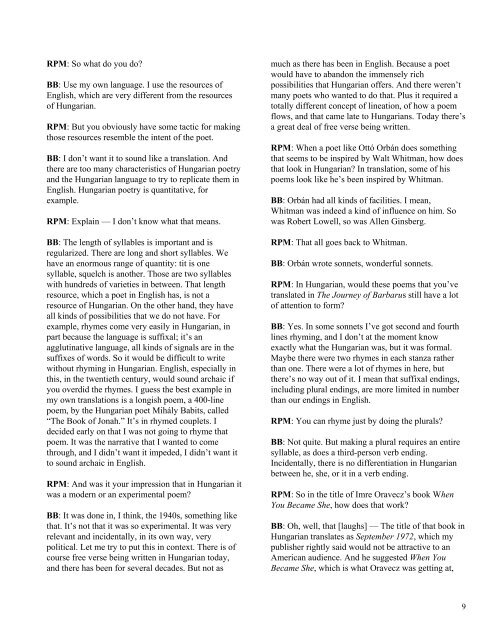their - The University of Texas at Dallas
their - The University of Texas at Dallas
their - The University of Texas at Dallas
You also want an ePaper? Increase the reach of your titles
YUMPU automatically turns print PDFs into web optimized ePapers that Google loves.
RPM: So wh<strong>at</strong> do you do<br />
BB: Use my own language. I use the resources <strong>of</strong><br />
English, which are very different from the resources<br />
<strong>of</strong> Hungarian.<br />
RPM: But you obviously have some tactic for making<br />
those resources resemble the intent <strong>of</strong> the poet.<br />
BB: I don’t want it to sound like a transl<strong>at</strong>ion. And<br />
there are too many characteristics <strong>of</strong> Hungarian poetry<br />
and the Hungarian language to try to replic<strong>at</strong>e them in<br />
English. Hungarian poetry is quantit<strong>at</strong>ive, for<br />
example.<br />
RPM: Explain — I don’t know wh<strong>at</strong> th<strong>at</strong> means.<br />
BB: <strong>The</strong> length <strong>of</strong> syllables is important and is<br />
regularized. <strong>The</strong>re are long and short syllables. We<br />
have an enormous range <strong>of</strong> quantity: tit is one<br />
syllable, squelch is another. Those are two syllables<br />
with hundreds <strong>of</strong> varieties in between. Th<strong>at</strong> length<br />
resource, which a poet in English has, is not a<br />
resource <strong>of</strong> Hungarian. On the other hand, they have<br />
all kinds <strong>of</strong> possibilities th<strong>at</strong> we do not have. For<br />
example, rhymes come very easily in Hungarian, in<br />
part because the language is suffixal; it’s an<br />
agglutin<strong>at</strong>ive language, all kinds <strong>of</strong> signals are in the<br />
suffixes <strong>of</strong> words. So it would be difficult to write<br />
without rhyming in Hungarian. English, especially in<br />
this, in the twentieth century, would sound archaic if<br />
you overdid the rhymes. I guess the best example in<br />
my own transl<strong>at</strong>ions is a longish poem, a 400-line<br />
poem, by the Hungarian poet Mihály Babits, called<br />
“<strong>The</strong> Book <strong>of</strong> Jonah.” It’s in rhymed couplets. I<br />
decided early on th<strong>at</strong> I was not going to rhyme th<strong>at</strong><br />
poem. It was the narr<strong>at</strong>ive th<strong>at</strong> I wanted to come<br />
through, and I didn’t want it impeded, I didn’t want it<br />
to sound archaic in English.<br />
RPM: And was it your impression th<strong>at</strong> in Hungarian it<br />
was a modern or an experimental poem<br />
BB: It was done in, I think, the 1940s, something like<br />
th<strong>at</strong>. It’s not th<strong>at</strong> it was so experimental. It was very<br />
relevant and incidentally, in its own way, very<br />
political. Let me try to put this in context. <strong>The</strong>re is <strong>of</strong><br />
course free verse being written in Hungarian today,<br />
and there has been for several decades. But not as<br />
much as there has been in English. Because a poet<br />
would have to abandon the immensely rich<br />
possibilities th<strong>at</strong> Hungarian <strong>of</strong>fers. And there weren’t<br />
many poets who wanted to do th<strong>at</strong>. Plus it required a<br />
totally different concept <strong>of</strong> line<strong>at</strong>ion, <strong>of</strong> how a poem<br />
flows, and th<strong>at</strong> came l<strong>at</strong>e to Hungarians. Today there’s<br />
a gre<strong>at</strong> deal <strong>of</strong> free verse being written.<br />
RPM: When a poet like Ottó Orbán does something<br />
th<strong>at</strong> seems to be inspired by Walt Whitman, how does<br />
th<strong>at</strong> look in Hungarian In transl<strong>at</strong>ion, some <strong>of</strong> his<br />
poems look like he’s been inspired by Whitman.<br />
BB: Orbán had all kinds <strong>of</strong> facilities. I mean,<br />
Whitman was indeed a kind <strong>of</strong> influence on him. So<br />
was Robert Lowell, so was Allen Ginsberg.<br />
RPM: Th<strong>at</strong> all goes back to Whitman.<br />
BB: Orbán wrote sonnets, wonderful sonnets.<br />
RPM: In Hungarian, would these poems th<strong>at</strong> you’ve<br />
transl<strong>at</strong>ed in <strong>The</strong> Journey <strong>of</strong> Barbarus still have a lot<br />
<strong>of</strong> <strong>at</strong>tention to form<br />
BB: Yes. In some sonnets I’ve got second and fourth<br />
lines rhyming, and I don’t <strong>at</strong> the moment know<br />
exactly wh<strong>at</strong> the Hungarian was, but it was formal.<br />
Maybe there were two rhymes in each stanza r<strong>at</strong>her<br />
than one. <strong>The</strong>re were a lot <strong>of</strong> rhymes in here, but<br />
there’s no way out <strong>of</strong> it. I mean th<strong>at</strong> suffixal endings,<br />
including plural endings, are more limited in number<br />
than our endings in English.<br />
RPM: You can rhyme just by doing the plurals<br />
BB: Not quite. But making a plural requires an entire<br />
syllable, as does a third-person verb ending.<br />
Incidentally, there is no differenti<strong>at</strong>ion in Hungarian<br />
between he, she, or it in a verb ending.<br />
RPM: So in the title <strong>of</strong> Imre Oravecz’s book When<br />
You Became She, how does th<strong>at</strong> work<br />
BB: Oh, well, th<strong>at</strong> [laughs] — <strong>The</strong> title <strong>of</strong> th<strong>at</strong> book in<br />
Hungarian transl<strong>at</strong>es as September 1972, which my<br />
publisher rightly said would not be <strong>at</strong>tractive to an<br />
American audience. And he suggested When You<br />
Became She, which is wh<strong>at</strong> Oravecz was getting <strong>at</strong>,<br />
9

















